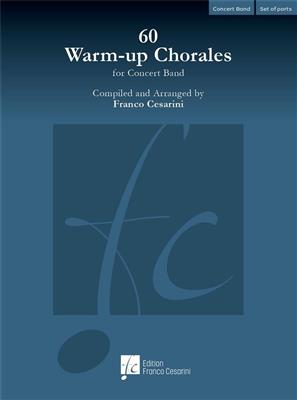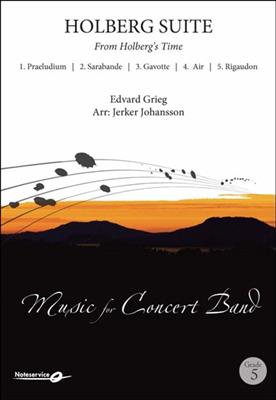Results
-
 £168.50
£168.5060 Warm-up Chorales for Concert Band
During his experience as a band conductor and teacher of wind orchestra conducting at university, Franco Cesarini has dealt with the topic of warm-ups very frequently. Throughout these long years of conducting he has had the opportunity to try many existing methods, evaluating their advantages and disadvantages.After a long time, he has decided to compile a collection of chorales for warm-ups, which are organized according to the criteria that he considers most effective.While working on his60 Warm-up Chorales for Concert Band, Franco Cesarini has always borne in mind that amateur musicians play for pleasure.He feels that it is extremely important that they have satisfaction at every moment of the rehearsal and not to start the rehearsal with needless "punishing" exercises. Nobody is really motivated to start playing with scales, long notes, or tricky rhythmical exercises. There is often a distinguished absentee in band rehearsals, namely music itself!Although this publication does not foresee a specific tempo for the chorales, they should often be performed rather slowly but without dragging.Dynamics are not indicated, so that the conductor has the opportunity to draw the attention of the musicians to his gestures and to make them react according to his indications.Timpani and bell parts have been added with the aim of not leaving the percussionists completely inactive during the warm-up phase, but can also be omitted.The chorales are written in four parts (SATB) and are also playable in smaller groups. The four voices can be played in different combinations of woodwinds or brass quartets or in mixed combinations.The collection includes ten chorales for the following keys: D flat major, A flat major, E flat major, B flat major, F major and C major.With his 60 Warm-up Chorales Franco Cesarini would like to convey the message to play the chorales in a musical way, thus raising the musicians' awareness of phrasing, the right interpretation of cadences, rubato and agogic.Above all, never do anything without putting the musical aspect in the foreground. 60 Warm-up Chorales for Concert Band: A perfect collection to warm-up and improve tuning of a concert band!
Estimated dispatch 7-14 working days
-
 £127.00
£127.00Ray of Light - Kevin Houben
Ray of light was composed for the 75th anniversary of the Royal Wind Band (De Heidegalm Berkenbos). The mining environment of Berkenbos (Heusden-Zolder, B) is a proof of what used to be one of the most flourishing industries inLimburg viz. the Mining Industry. Going down the shaft in the elevator for the first time was a sensational experience for every miner: the noise of the closing doors, the shock experienced when the lift cage started moving tofall down whizzingly into the deep at a speed of 30 km an hour. The opening theme of Ray of Light doesn't only reflect the bravery of the descending miners but also their anxiety, their doubt and insecurity. In the solo passage,the anxiety during the long walk in the dark through the mine corridors with only headlamps and mine lamps is clearly audible. Working in the mines wasn't without any danger. The very flammable and at times explosive mine gasesalways posed a hidden threat. Apart from that there was always the continuous danger of collapse. The beautiful choral movements are therefore an ode to the miners that left their lives in the mine. The eastern scale refers tothe multicultural character of the mining environment of Berkenbos with its many commercial shops and different types of housing inherent in mining architecture. The mining profession is still a very dangerous job, but at the endof the dark corridor the miners still see a beam of light as a sign of hope.
Estimated dispatch 7-14 working days
-
£78.95
Power - Larry Clark
This is one of Harold Bennett's (pseudonym of Henry Fillmore) lesser-known marches, but that is no indication of its quality. It is a 6/8 march in standard march form but what is unique about this classic from the original Bennett Band Book is that it is one of the few Bennett marches that includes a "break strain." This makes it a great introduction for younger students to prepare them to play the more challenging marches of Fillmore, Sousa, and others.
Estimated dispatch 7-14 working days
-
 £101.30
£101.30Marsj i april / March in April - Hans Offerdal
This very playable and fun march provides true feeling of Spring and sounds best in April, but can of course be played all year long! There are challenges for everyone, but Part 1 in Clarinet, Trumpet and Alto Saxophone is written a bit more difficult than Part 2. It is similar in Flute when playing divisi.
Estimated dispatch 7-14 working days
-
 £252.10
£252.10Holberg Suite - Edvard Grieg
Edvard Hagerup Grieg (1843-1907) was a Norwegian composer and pianist. He is widely considered one of the leading Romantic era composers, and his music is part of the standard classical repertoire worldwide. His use and development of Norwegian folkmusic in his own compositions put the music of Norway in the international spectrum, as well as helping to develop a national identity. Grieg is regarded as simultaneously nationalistic and cosmopolitan in his orientation, for although born in Bergenand buried there, he traveled widely throughout Europe, and considered his music to express both the beauty of Norwegian rural life and the culture of Europe as awhole.1884 was the bicentenary year of the birth of Ludvig Holberg (1684-1754)and as a part of the celebrations various Scandinavian composers were commissioned to write commemorative pieces. From Holbergs Time was one of Griegs contributions. It was first written for piano but in 1885 the composer transcribed it for stringorchestra. For his suite Grieg went back to some of the musical forms used by Holbergs contemporaries but although the forms and style may be rococo the contents are unmistakably characteristic of Grieg himself. Grieg gave the first performance ofthe piano version in Bergen, Holbergs birthplace, in December 1884.
Estimated dispatch 7-14 working days
-
 £50.50
£50.50Super Mom Symphony - Ed Huckeby
Bringing together your youngest players and your "coolest" Moms will be a huge hit with both the students and your audiences. "SuperMom Symphony" uses themes from Haydn and Beethoven and incorporates everything but the kitchen sink (OK, you can use that too if you really want to!). From the first pots and pans ostinato to the sustained blender "solo," this piece will have everyone "in stitches" and generating plenty of laughter and good will. P.S. You can use Dads as soloists also, but only if they can cook! Highly recommended for your first-year players!
Estimated dispatch 7-14 working days
-
 £65.99
£65.99Drivin' That Drummin' Machine! - David Shaffer
A very easy but solid rock tune that features the whole drum section. Full of fun and vitality and a great way to let your young drummers shine! Horn parts are powerful and provide a great backing for the percussion. Sure to be a big hit at any concert performance but mostly, this one is just a ton of fun!!!!
Estimated dispatch 7-14 working days
-
 £54.99
£54.99Conquest - Sandy Feldstein
A true "contest" style piece for the beginning band that uses limited note and rhythm resources, but is very creatively written. Your youngest students will feel like they are playing serious music, as the piece is bold, aggressive and sounds more difficult than it plays. This is the type of exceptional music you have come to expect from two of the most popular composers of beginning band music. This piece is correlated to The Yamaha Advantage band method book 1, but can be used with any band program of study.
Estimated dispatch 7-14 working days
-
 £60.99
£60.99It Started with a Kiss - Timothy Travis
This delightful ballad, in which the Alto saxophone plays a leading role, will remind many people of a very special moment in their lives. A lot could be said about it, but perhaps it is better to let the music speak for itself. While listening to this romantic ballad, unforgettable moments are sure to be relived by many people. Daydreaming is allowed, but don't forget to pay some attention to the soloist's performance it will be worth your while.
Estimated dispatch 7-14 working days
-
£60.99
God rest ye merry Gentlemen
'God rest ye merry, Gentlemen' is an ancient English carol. It was first published in 1833, but it can be traced as far back as the 15th century, which makes it one of the oldest carols known. 'God rest ye merry' is a Middle English salutation. In this manner, people wished one another greatness and might. In modern English, the first line of this carol would read 'May God keep you mighty, gentlemen'. Andrew R. Mackereth has not kept to the original words in his up-tempo arrangement of the carol. It is still clearly recognizable, but the arranger has taken a good many liberties. Sometimes a particular note is held longer, at times motifs follow oneanother in various parts. If you listen carefully, you may even be able to detect a motif from another well-known song.
Estimated dispatch 7-14 working days
